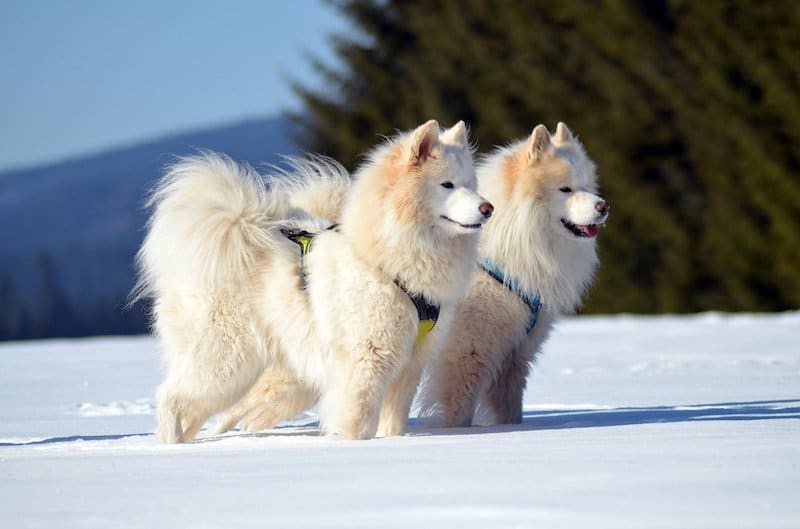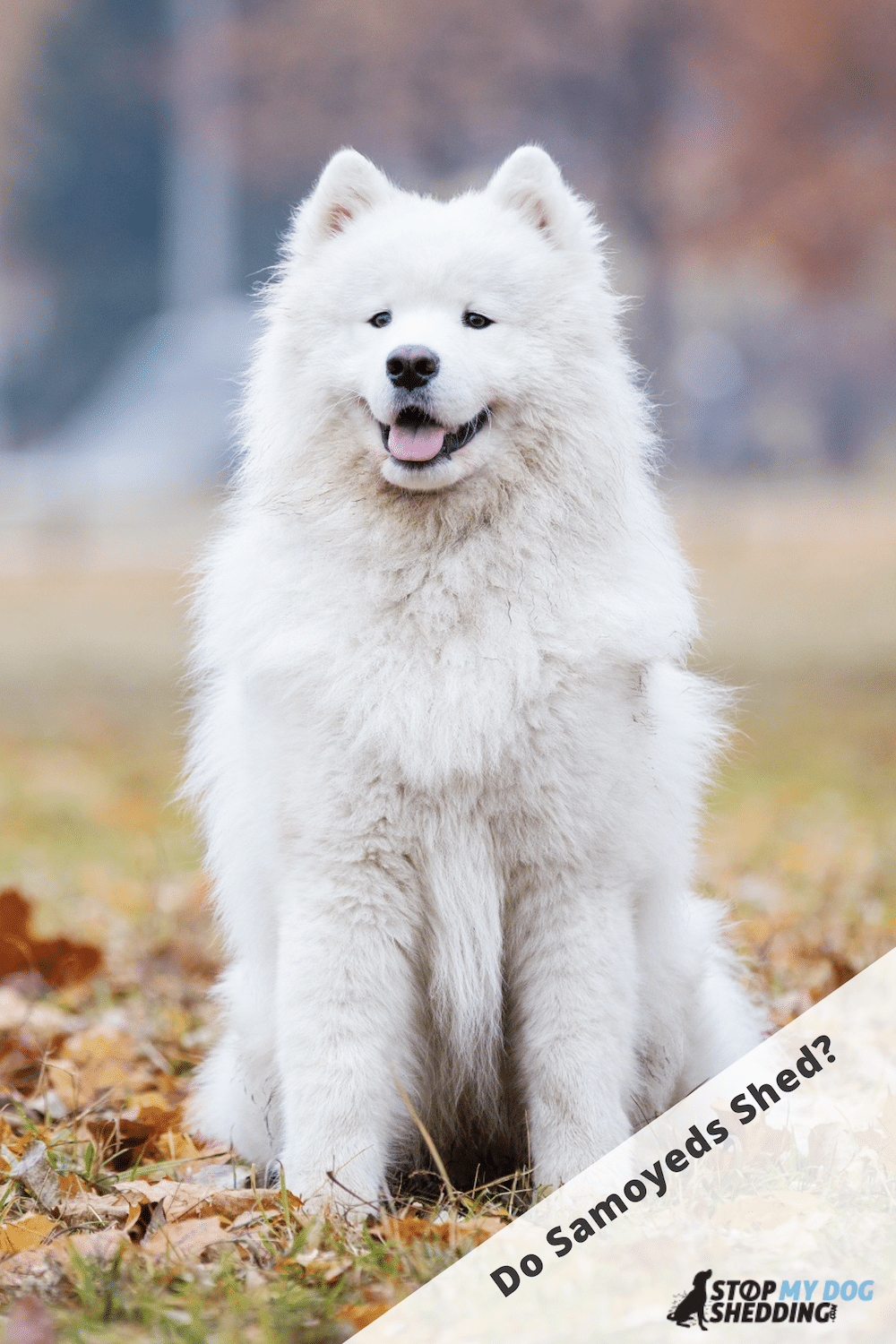Samoyeds are large working dogs that were bred to hunt, herd and guard reindeer, as well as sled heavy loads across frozen Arctic expanses, for the Samoyede people of Siberia.
They’re also incredibly cute! With fluffy white coats, dark almond shaped eyes, and a heart warming smile to boot, it’s hard not to fall completely in love with these beautiful dogs.
However, yes, they do shed. Lots!
Samoyeds have a profuse, weather-resistant double coat that sheds heavily throughout most of the year, and even more during periods of seasonal “coat blow” in spring and fall, which typically lasts for about 2-3 weeks. Daily brushing is needed to maintain their coat and reduce the shedding.
Let’s take a closer look at how much shedding to expect, what Samoyeds are like to groom, and some of the best ways to keep your home as fur-free as possible.
Samoyed Shedding – What to Expect
Samoyeds are a very heavy shedding dog.
They are right up there with the heaviest of heavy shedders, like the Alaskan Malamute, Siberian Husky, and Newfoundland for example.
And they don’t just shed constantly throughout the year either. Things tend to go from bad to worse during times like spring and fall (autumn) when they “blow their coat.” Which basically means they naturally shed (or molt) their coat in preparation for the change of season.
For example: in spring time, for about 2-3 weeks, Samoyeds molt their thicker winter coat because it is no longer needed for the upcoming warmer, summer months.
It does depend on the individual dog and what part of the world he lives in, among other factors, as to how noticeable this period of coat blow will be. But it’s safe to say you will notice a considerable increase in shedding at least once or twice per year due to this.
Why do they shed so much?
How much a dog sheds mostly depends on the breed. Put simply, some dogs shed more than others. However, the more elaborate answer is that is has to do with their hair growth cycle.
Dogs that shed lots tend to have one thing in common – it takes less time for their fur to go from the growth phase (anagen) to the part where it falls out and is replaced with new fur (telogen), than lower shedding dogs.
Shedding is also more noticeable among large dogs with thick, profuse coats, like the Samoyed. As opposed to small, high shedding dogs with a short coat, like the Pug. So, hypothetically, even if the fur is growing and falling out at the same rate, a larger dog with a more profuse coat is going to fill your home with more fur. And it’s typically going to be a lot more noticeable.

Sometimes shedding can be caused by things such as poor diet, stress, overheating, or fleas for example. So, if you do have any concerns about your dog’s shedding, contact a qualified veterinarian.
But some level of molting is perfectly normal among most healthy dogs. It’s just heavier and more noticeable with a Samoyed.
Recommended: Go here to see our top-rated dog hair blow dryers
How to Reduce Excessive Shedding
As annoying as constantly cleaning up loose dog hair can be, there is no “quick fix” or way to completely stop it. Molting is a natural process and something that actually benefits dogs.
Shaving their coat would be the only way to completely stop it (temporarily) and that is simply not a good idea. At least, not unless your vet specifically recommends it. Because dogs need their undercoats, they insulate them from both cold and hot weather, as well as protect their skin from things like sunburn.
The good news is, you can reduce excessive shedding and limit how much fur ends up floating around your home. And brushing, bathing and proper diet are among the simplest and most effective ways to do this. So let’s explore each of these in more detail.
Brushing
Brushing is without a doubt one of the most effective ways to minimize dog shedding. Not only does it remove the dead fur before it drops off of his coat, but brushing massages the skin and helps distribute his coat oils, which in turn can promote a healthier coat.
How difficult are they to brush?
Samoyeds aren’t the easiest dogs to groom. Regular brushing is needed to maintain their coat, keep it mat and tangle free, and remove the old, dead hair.
Throughout most of the year, brushing a few times per week, along with checking for mats after outings, should be enough to maintain their coat. However, during shedding season, or if you just want to keep as much fur out of the home as possible, you may need to brush daily.
What sort of brush should you use?
As always, this really depends on the dog’s coat. The Samoyed has a profuse, weather-resistant double coat (two layers of fur instead of just one). His outer coat is harsh, straight and long, and comes in colors like white, cream or biscuit. While the undercoat is thick, soft and wooly.
And a slicker brush or metal comb work well on coats of this type.
A slicker is a dog brush with fine, and slightly angled, wire bristles with plastic caps on the end. And I prefer a metal comb with teeth that are narrower on one end and wider on the other, as this gives you some flexibility as you brush.
Together, these help remove any mats, tangles and knots he has accumulated, along with any dead fur. Some prefer an undercoat rake or deshedding tool to get right down to the undercoat during shedding season. But this is personal preference, a simple metal comb can work just as well.
Bathing
Bathing is another effective way to help maintain the coat of a Samoyed and remove his old fur. He generally only needs to be bathed every few months or so because he’s not a particular smelly dog. But during shedding season bathing can be very effective, especially prior to a thorough brushing.
It’s important not to over bathe him though. Because doing so can strip his coat of its natural oils and dry out his skin and hair, which in turn can make the shedding worse.
And it’s always worth using a high quality dog shampoo, preferably one that adds moisture to the skin, as cheap shampoos or ones meant for humans can cause dryness and irritation.
Here’s a helpful video I found on bathing your Samoyed:
Proper Diet
Besides grooming, making sure your Samoyed’s diet is optimal is one of the most important things you can do to help reduce excessive molting. And selecting the right food is something your vet should be able to help you with.
However, as a general guide, low quality dog foods made from cheap ingredients can often lead to increases in shedding. And at best, aren’t going to make the situation any better. On the other hand, dog foods that have the right amount of vitamins, minerals, protein and that provide him with the best nutrition possible, can help him develop a healthier coat.
Not to mention, healthy fatty acids like Omega-3 and Omega-6 can be beneficial for the skin, which is why most quality dog foods contain these.
There are also some great supplements out there, but it’s important to keep in mind that some of the so-called “dog shedding supplements” aren’t as good as they are marketed to be. And some find that things like virgin coconut oil are just as, if not more, beneficial.
Related: Does Coconut Oil Really Help With Shedding?
Either way, there is no one dog food or supplement that can magically stop the shedding. But a good quality dog food, together with a solid grooming routine, can help you win the battle.
Are Samoyeds Really Hypoallergenic?
One of the interesting things about the Samoyed is that, even though he’s a (very) heavy shedder, the general consensus is that he’s hypoallergenic. But is he really, or is this just nonsense? Well, to answer this question properly, we need to first establish what a “hypoallergenic dog” actually is.
According to Wikipedia, a hypoallergenic dog is “purportedly more compatible with allergic people than are other breeds.”
If you read the above Wikipedia article, and research the topic further as I have, you’ll see that there is no such thing as a 100% hypoallergenic dog breed. There are just some breeds which are more suitable for people with pet allergies than others.
So, in reality, a hypoallergenic dog is just a term used in dogdom to describe dogs that are “generally more suitable for allergy sufferers than others.”
What makes one dog more hypoallergenic than another?
Well, according to an article on Healthline, the main cause of allergies to dogs is not the hair itself, but rather their dander (dead skin), urine and saliva. The article also states that “different breeds produce different dander, so it’s possible to be more allergic to some dogs than others.”
So the problem is not the hair, it’s the dander and other allergens like saliva. Which may help explain why a heavy shedding dog like the Samoyed is considered by some to be hypoallergenic. Especially since they don’t drool much.
However, there are some important caveats here:
- Firstly, all dogs can cause allergies, even hairless breeds. So, at best, the Samoyed may be “generally more suitable” for people with dog allergies than some other dogs.
- Second, even though the hair itself isn’t the cause of dog allergies, dander readily attaches itself to a dog’s fur. So, the more he sheds, the more dander is going to spread around the home.
- Third, there is some disagreement over whether or not Samoyeds are non-allergenic or not to begin with. And one of (if not the) most trusted site in the dog space (the American Kennel Club) does NOT list Samoyed as a hypoallergenic breed.
- Lastly, in an article about Samoyeds, the AKC states that “most of those breeds considered best for allergy sufferers are non-shedding breeds.” And suggests exercising caution before buying one if you’re an allergy sufferer.
So, to sum it up, Samoyeds might be more suitable than some dogs for those who suffer from allergies. But whether or not they are “hypoallergenic” is another story. Either way, I think it’s important to do your own research, before buying any dog based on how non-allergenic it’s purported to be.
Bottom Line
Samoyeds really are an amazing breed. Not only are they strong, smart, and tireless working and herding dogs, but they’re incredibly cute and make great family companions. One look at this “Smiley Sammy” (as he’s sometimes called) is enough to melt just about anyone.
But there’s no getting around it – they molt.
And grooming them takes some effort. So if you want a perfectly hair-free home and don’t want to put the effort into grooming him, he may not be the best breed for you.
If you’re looking for a lower shedding working dog, the Soft Coated Wheaten Terrier might be more suitable. Or low shedding working dogs that are also easier to groom, include breeds like the Cane Corso and Standard Schnauzer.













Please note: By submitting a comment using the above comment form, you confirm that you agree with the storage and handling of your data by this site as detailed in our Privacy Policy.